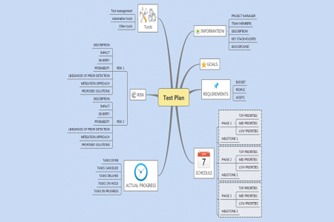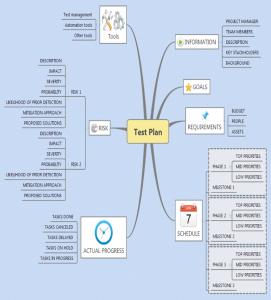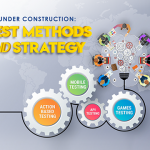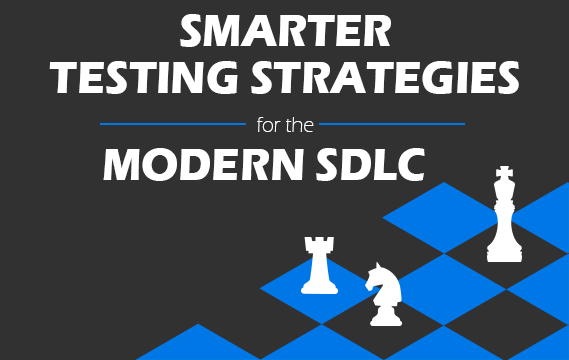Plan your Test Cases with these Seven Simple Steps
What is a mind map?
A mind map is a diagram used to visually organize information. It can be called a visual thinking tool. A mind map allows complex information to be presented in a simplified visual format. A mind map is created around a single concept. The concept is represented as an image in the center to which the associated ideas are added. Major ideas are connected directly to the central concept, and other ideas branch out from those.
Mind mapping is great for note taking, planning, studying, brainstorming etc. The term “mind map” was first used by Tony Buzan in 1974. In school, I preferred visual mind mapping over traditional note-taking, and it proved to be a great aid to revise and recall the concepts quickly. This is because the information in a mind map is structured in a way that mirrors exactly how the brain functions — in a radial rather than linear manner. A mind map literally maps out your thoughts, using associations, connections and triggers to stimulate further ideas.
How to draw a mind map:
Creating a mind map doesn’t take artistic talent or exceptional creative ability. Just let your brain flow naturally.
Tony Buzan, the father of mind maps, suggests the following steps:
1. Start in the center of a page.
Why? Because starting in the center, gives your Brain freedom to spread out in all directions and to express itself more freely and naturally.
2. Use an IMAGE or PICTURE for your central idea.
Why? Because a picture is worth a thousand words and images help you use your imagination. A central image is more interesting, keeps you focused, helps you concentrate and gives your brain more of a buzz!
3. Use COLORS throughout.
Why? Because colors are as exciting to your brain as images are. Color adds extra vibrancy and life to your mind map. It also adds tremendous energy to your creative thinking, and is fun!
4. CONNECT your MAIN BRANCHES to the central image and connect your second and third level branches to the first and second levels, etc.
Why? Because your brain works by association. It likes to link two (or three, or four) things together. If you connect the branches, you will understand and remember a lot more easily.
5. Make your branches CURVED rather than straight
Why? Because having nothing but straight lines is boring to your brain.
6. Use ONE KEY WORD PER LINE.
Why? Because single keywords give your mind map more power and flexibility.
7. Use IMAGES throughout.
Why? Because images make an impact. Like the central image, all subsequent images are also worth a thousand words. So, if you have only 10 images in your mind map, it’s already equal to 10,000 words of notes!
How to use mind mapping techniques in software testing?
PRO TIPS
If a mind map is getting too big or complicated try splitting it.
Do not use long detailed sentences in mind maps.
Develop your own personal style of mind mapping.
Mind maps can be used in all the test stages from test planning to test case execution.
- Test Planning
- Requirement analysis
- Impact analysis
- Task allocation
- Test case design
- Traceability
- Test reporting—quick test reports
Test Planning
While test planning, you can draw an initial mind map keeping in mind the list of tasks, schedules, tools, roles, responsibilities, milestones, etc. Present the mind map and discuss it with your stakeholders. Modify the mind map if any changes are required. One thing you will love about mind maps is that they have the flexibility to adapt to changes—simply by adding or removing a node/branch. This flexibility might not happen when you draw on a paper, but a mind mapping software facilitates any changes.The final mind map shows you the scope of testing in one glance. This can be used as a blueprint and later converted into a plan. This ensures that no test activity is missed.
Test case design
Mind maps are an efficient way of creating lean test cases: It reduces the time required for creating test cases that yield better results. Mind maps are very easy to maintain and are flexible to changing requirements.
Draw branches from every user story/epic and associate all its functionalities as sub-nodes. Start adding test ideas/test cases for each functionality.
I created a mind map covering test ideas for major functionality. My team started to expand the mind map by branching out more and more test ideas. We kept adding new nodes when we found unique scenarios that uncovered bugs during our test sessions. This drastically increased our test coverage. The final mind map can be as the basis for a test case document or it’s okay if it’s used as is.
The best part of mind mapping is that you generate more ideas when drawing them. Collaborative mind mapping with the team gives you the best results.
Traceability mind map
A traceability matrix is an essential tool for every tester to analyze and improvise the test coverage. You can use a mind map instead of a tabular traceability matrix.
To create a traceability mind map:
First add nodes of all the epics. Then, draw branches from every module and associate all its user stories as subsequent nodes. Now, link the test cases for every functionality. You can also link the requirement number of the test management tool. This ensures that you have not missed writing test cases for any user story. This mind map gives you the birds-eye view of your test coverage. You can identify the areas where you need to strengthen your coverage.
You can use mind maps anywhere and everywhere!
Tools
There are tons of commercial and open-source tools that lets you visualize your ideas as a mind map. I prefer the following tools:
Xmind(Windows/Mac/Linux)- Probably the most popular and free mind mapping tool.
Coogle(Web app) – Coogle is a web app that lets your team collaborate and work on a single mind map.
The use of mind maps is becoming popular with agile testers and lean test practitioners. When will you start using mind maps?






















